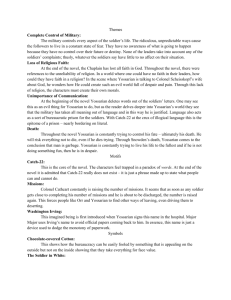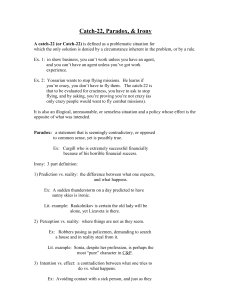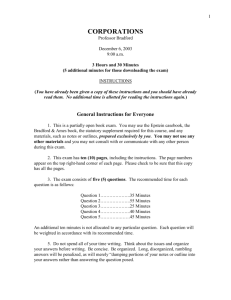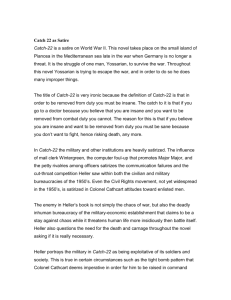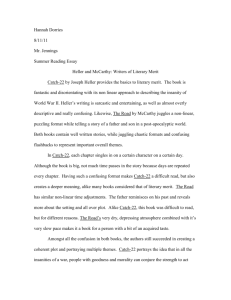catch 22 3
advertisement
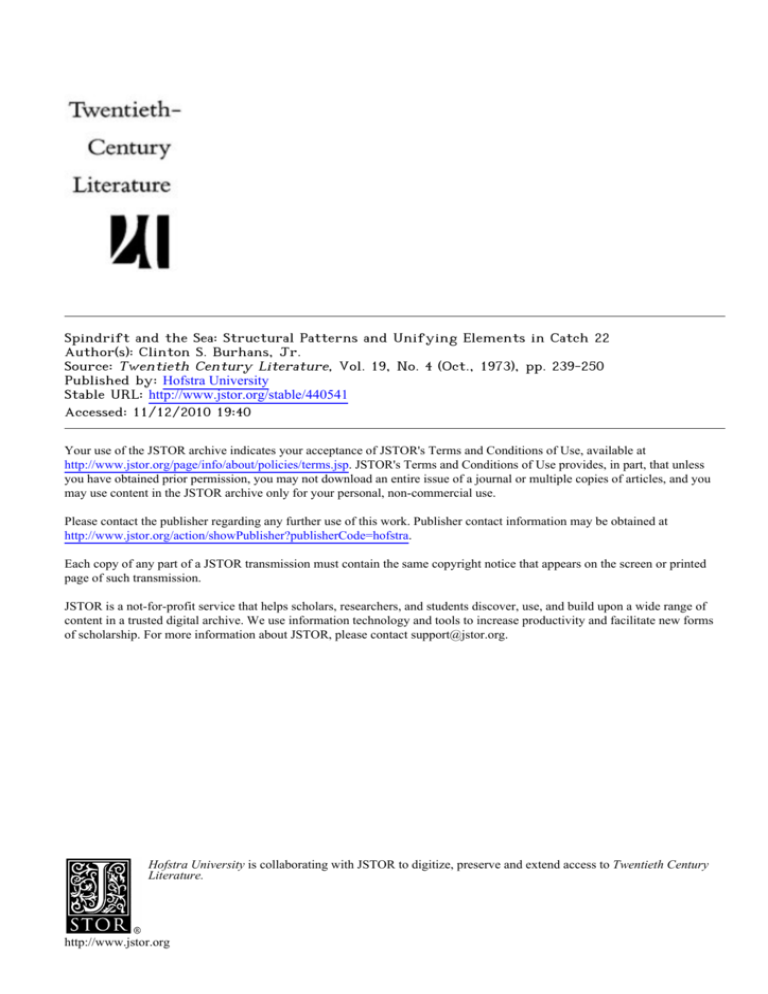
Spindrift and the Sea: Structural Patterns and Unifying Elements in Catch 22
Author(s): Clinton S. Burhans, Jr.
Source: Twentieth Century Literature, Vol. 19, No. 4 (Oct., 1973), pp. 239-250
Published by: Hofstra University
Stable URL: http://www.jstor.org/stable/440541
Accessed: 11/12/2010 19:40
Your use of the JSTOR archive indicates your acceptance of JSTOR's Terms and Conditions of Use, available at
http://www.jstor.org/page/info/about/policies/terms.jsp. JSTOR's Terms and Conditions of Use provides, in part, that unless
you have obtained prior permission, you may not download an entire issue of a journal or multiple copies of articles, and you
may use content in the JSTOR archive only for your personal, non-commercial use.
Please contact the publisher regarding any further use of this work. Publisher contact information may be obtained at
http://www.jstor.org/action/showPublisher?publisherCode=hofstra.
Each copy of any part of a JSTOR transmission must contain the same copyright notice that appears on the screen or printed
page of such transmission.
JSTOR is a not-for-profit service that helps scholars, researchers, and students discover, use, and build upon a wide range of
content in a trusted digital archive. We use information technology and tools to increase productivity and facilitate new forms
of scholarship. For more information about JSTOR, please contact support@jstor.org.
Hofstra University is collaborating with JSTOR to digitize, preserve and extend access to Twentieth Century
Literature.
http://www.jstor.org
Clinton S. Burhans, Jr.
Spindrift and the Sea: Structural
Patterns and Unifying Elements
in Catch22
If my experience is at all representative, a particular and unusual danger
lurks in the serious study of this work. Inevitably, there comes a time when,
looking around at accumulations of notes, charts, and commentaries, you suddenly bust out laughing at yourself in an unexpected illumination of your own
absurdity in taking the thing so seriously. In that strange flash of disorientation,
you feel like one of Heller's characters, like maybe a bookkeeper for Milo
Minderbinder.
Fortunately, this fit of sudden sanity dissolves, as it rightly should; for the
comic anarchy which provokes it is only the surface of Catch-22, not its sustaining structure. Critics have consistently been challenged by the question of
the work's structure and unity and with various and conflicting results. In the
main, such discussions center around two viewpoints: some critics argue that
the work is episodic and formless; others find it organized according to some
particular principle or method.' Neither position, it seems to me, need necessarily, nor in fact does, exclude the other. The narrative surface is obviously
episodic and apparently chaotic; but this surface formlessness is central to the
novel's thematic experience, and it rises from strong and multi-level structural
patterns and a variety of unifying devices.
Seeking these patterns and devices in Catch-22 involves a long and often frustrating analysis, beginning with an elusive sense of underlying structure and
unity and ending with that sense becoming conviction amidst an overwhelming
239
TwentiethCenturyLiterature
mass of supporting information. Despite the constant episodic zigzags which
comprise Catch-22's narrative surface, the novel is built on a central conflict,
two sub-plots, and a host of motifs. What Heller has done is to break up the
logical and chronological development of these narrative elements by taking bits
and pieces of all three and mixing them together with dashes of expository and
rhetorical comment without regard to logical or temporal or spatial connection.
The result is an apparent-but only apparent-jumble of comment, character,
and event consistent with contemporary esthetic tendencies away from reason,
time, and space as ordering categories.
Nevertheless, a basic narrative structure can be discovered holding the novel
subtly together. This structure can best be visualized as a kind of narrative tree,
with the trunk comprised primarily of the main plot (Yossarian's efforts to get
off flying status either by achieving the required number of missions or by having
himself declared insane) and two sub-plots (the struggle between Peckem and
Dreedle for command of the Wing, and Milo's syndicate). Around this trunk
grow in abundance two kinds of branches, arranged for visual convenience one
on either side. Those on the left, whether simple references or detailed episodes,
are expository flashbacks made once for informational purposes or repeated for
thematic effect. Those on the right are a different kind of flashback, one which
I have not encountered elsewhere. The best way to describe them, I think, is
to call them foreshadowing flashbacks; that is, again whether simple reference
or detailed episode, most of them after the first add links in a chain of information drawn out and completed at some length. Thereafter, references to these
subjects become conventional flashbacks repeated for thematic effect. The result
is the paradox of suspense through flashbacks; and, I think, as this paradox
suggests, an ingenious fusion of time planes into the simultaneity of existential
time, a fusion entirely consistent with what seems to me the fundamental existential theme of the work.
Visualizing this narrative tree and looking down it, one discovers that Heller
has done something in each chapter to link it to the preceding chapter-a continuing action or condition, references to time or to historical events, mention of
the number of missions required or flown. Sometimes these links are slight and
tenuous, as in Chapters Six, Eight and Twenty-four; they may appear at the
beginning or be buried in the middle or only surface in the end; still, they are
usually there, and they do function, if only subliminally, to tie the narrative together.
Amplifying this masked but functional narrative continuity, Catch-22 develops
in a five-part alternating structure. The trunk of the narrative tree bends twice,
breaking its straight line into three sections and two substantial bulges. The first
part, through Chapter Ten, establishes and develops the narrative present; that
is, each chapter, however fragmented in time or place, event or character, does
something to maintain and advance the narrative present and its problems estab-
240
Catch-22/Burhans
lished in the opening chapters. The second part flashes back to the Great Big Siege
of Bologna in Chapters Eleven through Sixteen; and a third part returns to the
narrative present as in the first part in Chapters Seventeen to Twenty-two. Another
long flashback, this time to Milo Minderbinder's operations and to the origins
and growth of his M & M Enterprises, forms a fragmentary but essentially sustained fourth part in Chapters Twenty-two through Twenty-four. A fifth part
returns again to the narrative present in Chapter Twenty-five and remains there
with increasingly less fragmentation to the end.
That these structural sections are neither arbitrary nor accidental is suggested
by the clearly transitional chapters with which Heller surrounds the two major
flashbacks. Chapter Ten ends by introducing the Great Big Siege of Bologna;
and Chapter Seventeen opens shortly after the two Bologna missions by returning Yossarian to the hospital at the time of Chapter One and ends with Yossarian
out of the hospital again and coming to Doc Daneeka a second time for aid after
Major Major had refused to help him in Chapter Nine. Similarly, Chapter Twentytwo introduces the earlier trip to Cairo on which Milo had tried to corner
Egyptian cotton; and Chapter Twenty-five refers both to the Chaplain's seeing
a naked man in a tree at Snowden's funeral-the episode which ends Chapter
to his continuing efforts in the narrative present to help
Twenty-four-and
Yossarian and the other men by trying to get the required number of missions
reduced.
Despite Catch-22's many and sudden shifts in scene, episode, character, motif,
and time, then, the narrative trunk makes it clear that Heller has distributed
sufficient elements of continuity and transition to give the work a controlling
structural design beneath its kaleidoscopic surface. However much this narrative
surface may disguise it, Catch-22 is built on a five-part alternating structure in
which sections developing the central conflict and sub-plots in the narrative present (parts one, three, and five) alternate with long flashback sections providing
additional background and exposition and also functioning to fuse the work's
time planes (parts two and four).
Another glance down the narrative tree suggests a second structural pattern,
a tonal structure. Beginning with the end of Chapter Twenty-nine and Chapter
Thirty and culminating in Chapter Thirty-nine, the novel darkens measurably
into almost insupportable horror. The crucial episode is the mission against the
undefended mountain village, a totally unnecessary mission in which poor people
unconnected with the war are to be killed without warning for publicity photos
of tight bomb patterns. The tonal shift in this episode is clear and sharp. Earlier
episodes focus on individual combatants as voluntary or involuntary participants
in a familiar if horrifying and ridiculous game with ultimate consequences, like
the descriptions of Yossarian's experiences on missions; or on perils and death
remote in time, like the Ferrara mission; or on horrors contained within farcical
241
TwentiethCenturyLiterature
situations, like Milo's bombing of the squadron. Such episodes reflect real horrors but to some degree, at least, cushion the reader against experiencing them,
insulate their effects on him. Not so with the mission against the mountain village.
It is immediate; it is probable; it is barren of justification; it is stark murder; it is
unspeakable outrage; it is uncushioned horror. Even Dunbar, who has up to this
point looked primarily after himself and sought only to lengthen his life span by
taking no unnecessary risks whatever, rises in protest, denounces the mission,
and risks court-martial by intentionally missing the village.
The tonal shift I am suggesting here is indicated in several other ways as
well. Four of the novel's five basic structural sections and the beginning of the
fifth precede the mission to the mountain village; no basic structural change follows it. Clearly, something different is going on in this final third of the novel
from the structural alternation of the first two-thirds: something more focused,
more concentrated, more intense. Similarly, most of the novel's riotous fragmentation of time, place, character, and event occurs in its first two-thirds: most of
the flashbacks, for example, appear in these chapters. The ratio is around four
or five to one, not only in number but also in the variety of their subjects, again
suggesting a more intense focus in the novel's final third on the narrative present
and its immediate problems. Finally, despite the long months of peril, neither
Yossarian nor any of his friends, the central characters in the novel, die before
the mission to the mountain village. But one by one they die or disappear thereafter, like lights going out in a gathering darkness.
A three-part tonal structure, then, seems evident. The first part, Chapters One
through Twenty-nine, establishes the tone by which the novel is usually characterized: a predominantly and broadly humorous tone, a mixed tone in which
fear and desperation are contained within and controlled by exploding jokes,
gags, puns, parodies, and satiric attacks, the tone of a fireworks display in a
thunderstorm. The second part, Chapters Twenty-nine through Thirty-nine,
pivoting on the mission to the mountain village, shifts to a much different and
more consistent tone, one of deepening despair whose growing darkness envelops
the humor and turns it increasingly sick and savage. The third part, the last
three chapters, shifts again to another mingled tone, one of resigned desperation
broken by revelation and release.
Within these general structural patterns of organization and tone, Catch-22's
central conflict develops in a conventional plot and sub-plot structure. The central conflict is, of course, Yossarian's struggle to survive the war either by flying
the required number of missions or by getting himself removed from combat
status. In each purpose, he finds himself constantly blocked: Col. Cathcart keeps
raising the required number, and the military system functions by insuperable
devices for keeping Yossarian on combat status. The resulting conflict develops in
a generally classical pattern: exposition, initiation, complication, rising tension,
crisis, and climax moving in the main chronologically and climactically within a
242
Catch-22/Burhans
welter of expository and foreshadowingflashbacksand providing points of departurefor a host of related puns, jokes, parodies, and satiric attacks.
Catch-22 begins in medias res with Yossarian in full and close pursuit of the
magic number: 45 missions are required,and he has flown 44. In ChapterTwo,
Col. Cathcartraises the number to 50 and in Chapter Six, when Yossarian has
48, to 55. In ChaptersNine and Seventeen, Yossarian has reached 51, but in
Chapter Nineteen, the magic number rises to 60. By Chapter Twenty-eight,
Yossarian is once more closing in; but Cathcart raises the ante again, to 65 in
Chapter 30 and to 70 in Chapter 31. In Chapter Thirty-five,Cathcart raises to
80; and Yossarian,after reaching71, decides in ChapterThirty-eightto end this
exercise in futility and fly no more.
Flashbacksprovide additional informationon Yossarian'sefforts to gain this
elusive militarybrass ring. ChapterSix returnsto the previous Fall when 25 missions were requiredand Yossarianreached 23 by flying six missions in six days.
At that point, Col. Cathcartbecame the new group commander and raised the
number to 30 in celebration. By the time of the Orvieto mission the following
Spring, 35 missions were required (Chapter Ten); and after the two Bologna
missions,when Yossarianhad 32, the numberincreasedto 40 (ChapterSixteen).
In Chapter Seventeen, Yossarian reached 38, and Cathcart raised again to the
45 requiredin ChapterOne.2
A similar pattern emerges from the second aspect of Yossarian'sstruggle to
survive: his effortsto get off combat status. After leaving the hospital in Chapter
One, he tries unsuccessfully to persuade Doc Daneeka to help him (Chapters
Four and Five) and considers refusing to fly any more missions (Chapter Six).
He decides to go to Major Major;and when he refuses to help (ChaptersSeven
and Nine), Yossarian tries Doc Daneeka again (Chapter Seventeen). He asks
the Chaplain for help, and the Chaplain responds vigorously but without result
(Chapters Nineteen, Twenty, Twenty-five). After Yossarian is wounded over
Leghorn, the psychiatristat the hospital certifies him insane but confuses him
with anotherpatient, who gets sent home instead of Yossarian; and he tries Doc
Daneeka again (Chapter Twenty-Seven). In Chapter Thirty-eight,he refuses to
fly any more missions; and after recognizingthat he cannot go through with his
deal with Cathcart and Korn (Chapters Forty and Forty-one), he deserts.
Here, too, flashbacksfill in importantbackground material. In ChapterTen,
Yossarian decides not to fly the first Bologna mission; and in ChapterFourteen,
he aborts by forcing Kid Sampson to turn back. On the Avignon mission, he is
smeared with Snowden'sblood and viscera and refuses to wear a uniform again
(ChapterTwenty-four). And a final flashbackrevealingthe full import of Snowden'ssecret revealsas well the deepest motivationof Yossarian'sstruggles(Chapter Forty-one).
243
TwentiethCenturyLiterature
Like the structural and tonal patterns, then, this two-pronged central conflict
functions coherently at the heart of Catch-22, though it is not always immediately
or continuously available. In less detailed and more fragmentary form, two subplots work similarly within the apparent welter of the novel's surface. The lesser
of these is the contest between Generals Peckem and Dreedle for command ot
the Wing. The background and opening moves of this contest are suggested in
Chapter Three, and Peckem's aims and campaign appear in Chapters Twelve
and Nineteen. General Dreedle's position and ultimate defeat are indicated in
Chapter Twenty-one, and Scheisskopf joins Peckem and learns of his real war in
Chapter Twenty-nine. In Chapter Thirty-six, Peckem replaces Dreedle, only to
discover that his command is now under the broader jurisdiction of the newly
promoted Scheisskopf (Chapters Thirty-seven and Forty).
A more fully developed sub-plot describes the rise of Milo Minderbinder from
new mess officer to business manager of the whole war as head of M & M Enterprises. As with Yossarian, Milo's story begins in medias res. Chapters Two, Seven,
and Nine reveal his extravagant and luxurious mess-hall operations in full bloom;
and flashbacks in Chapters Ten, Twelve, and Thirteen explain how Milo became
a mess officer and describe some of the operations of M & M Enterprises.3 Syndicate operations and Milo's spreading influence and power appear in Chapters
Nineteen, Twenty-one, and Twenty-two; and Chapter Twenty-four is a flashback to the beginnings of M & M Enterprises and its major operations. Chapters
Twenty-eight, Thirty-five, Thirty-nine, Forty-one, and Forty-two reflect further
glimpses of Milo's gourmet mess halls and his increasingly ubiquitous syndicate.
In Chapter Forty-two, Col. Cathcart and ex-P.F.C. Wintergreen have joined
Milo; and he is well on his way not only to controlling the war but also to owning
the world by giving everyone a share in n.
As the narrative tree suggests, then, the episodic and fragmented narrative
surface of Catch-22 masks and is sustained by a complex and multi-dimensional
structural design compounded of an alternating five-part basic structure, a threepart tonal structure, and a conventional plot and sub-plot structure. Moreover,
this complex structural design is reinforced by several unifying devices: chronology, recurring characters, and a variety of motifs. The result is paradox:
structure and unity sustaining and controlling episodic chaos.
However much the narrative surface may obscure it, the events of Catch-22
are chronologically related. Heller refers to several specific dates and occasions
and to historical events, and these can be supplemented by time references and
cross-references in the text. We know, for example, that it is late August when
the Chaplain talks to Col. Cathcart about lowering the missions from the new
number of 60 (203, 283)4 and that this conversation occurs at least several weeks
after Yossarian leaves the hospital at the beginning of the story. We also know,
244
Catch-22/Burhans
from a reference to his rest leaves in Rome (18), that Yossarian leaves the hospital and returns to his tent at least several weeks after the fall of Rome on June
6, 1944. We can thus infer that the narrative present at the beginning of the story
is sometime in July, 1944. When Yossarian returns from the hospital at that
time, he learns that Col. Cathcart has raised the required missions to 50; and a
short time later, probably in middle or late July, he raises the number to 55. At
this point, Yossarian recalls the death of Mudd "three months earlier" (111-12);
therefore, since Mudd died on the Orvieto mission, we can date that mission as
sometime in April, 1944.
By thus using firm dates and events as constant reference points and by crosschecking against them and against each other the main episodes of the novel, it
is possible to organize an occasionally loose but generally reliable chronology
for Catch-22:
1941
1941-1943
: Yossarian in Army-qualifies for transfer to Air
Cadet training
: Yossarian an Air Cadet at Santa Ana, California,
and Lowery Field, Colorado-Grand Conspiracy
of Lowery Field
NOVEMBER 26, 1941 : Yossarian in hospital at Lowery Field
NOVEMBER 26, 1942 : Yossarian in hotel room with Mrs. Scheisskopf
1943
:Yossarian goes overseas via Puerto Rico-Splendid
Atabrine Insurrection
SEPTEMBER, 1943
: Required missions at 25
Nevers
Yossarian flies his 23rd, to Arezzo-Col.
of Salerno beachhead-missions
killed-time
raised to 30
APRIL, 1944
MAY, 1944
Beginning of M & M Enterprises-Orvieto
-death of Mudd
mission
:Required missions at 35
Development of M & M Enterprises-Milo tries
to corner Egyptian cotton
Ferrara mission-deaths of Kraft and Coombsfirst soap poisoning of mess
Milo bombs squadron
General Peckem schemes to take over combat command
Great Big Siege of Bologna-second soap poisoning of mess-Yossarian's 32nd mission-missions
raised to 40
Yossarian goes into hospital
245
TwentiethCenturyLiterature
JUNE, 1944
: Yossarian leaves hospital, flies six more missions
time of fall of Rome
Yossarian and Orr on leave trip with Milo
Avignon mission-death of Snowden
Yossarian naked in tree at Snowden's funeral
Yossarian naked at decoration for bravery in Ferrara mission
Clevinger disappears in cloud
: Missions raised to 45-Yossarian has 38, goes into
hospital again-time of beginning of book
Yossarian leaves hospital-missions raised to 50
JULY, 1944
AUGUST,
1944
Yossarian flies four more missions-missions
to 55
raised
Yossarian flies 51st mission
Yossarian tries to punch Col. Cathcart in Officer's
Club
Missions raised to 60; Paris liberated (August 25,
1944)
General Peckem gaining in struggle with General
Dreedle
SEPTEMBER, 1944
: Yossarian wounded over Leghorn-goes into hospital again-Americans pushing into Germany, 8th
Army takes Rimini, Gothic Line collapsing
Yossarian returned to combat status-flies two
more missions-second
Avignon mission-Orr
shot down again
Third Bologna mission-Orr shot down and disappears
Scheisskopf joins General Peckem's command
Raid on small Italian mountain village-Germans
above Florence
Deaths of Kid Sampson and McWatt-missions
raised to 65
OCTOBER, 1944
NOVEMBER,
1944
: Missions raised to 70
Yossarian gets new roommates-two months after
invasion of Southern France (August 15, 1944)
: Yossarian breaks Nately's nose on Thanksgiving
Day-goes into hospital to see Nately-Dunbar to
be disappeared
Yossarian has 70 missions-Chief
White Halfoat
dies
246
Catch-22/Burhans
DECEMBER, 1944
: Missions raised to 80-Dobbs and Nately killed
on La Spezia mission
General Peckem becomes wing commanderunder General Scheisskopf
Yossarian has 71 missions, refuses to fly any more
-Dunbar and Major Major disappear
Yossarian knifed by Nately's whore-goes back
into hospital
Hungry Joe dies
Col. Cathcartand Ex-P.F.C. Wintergreenpartners
in M & M Enterprises
Yossarian deserts-Germans driving towards Antwerp in Battle of Bulge
Despite the generalconsistencyof this chronology, Heller occasionally errs in
computation. For one, it seems unlikely that Cathcart would increase the required number of missions only by ten in the seven or eight months between
September,1943, and May, 1944; and it seems even more unlikelythat Yossarian
would fly only nine missionsin the same period-especially after flying six missions in six days in September.The relationshipbetween the number required
and the numberYossarianflies is consistent, but the totals are implausible.For
another,Heller says at one point that Milo bombed the squadron"seven months"
after the period in which Yossarianwas an air cadet at Lowery Field in Colorado
(109). But Milo formed his syndicate after April, 1944 (247), and Yossarian
had already flown 23 missions seven months earlier in September, 1943 (54).
Clearly,then, Heller is off here by a year or two. Again, CaptainBlack'sGlorious
Loyalty Oath Crusadeis ended by Maj. - de Coverley when he returns to the
squadronfrom Rome shortly after the fall of the city in June, 19445 (119-20).
But Captain Black began his Crusade when Major Major was made squadron
commanderinsteadof him (116), and Major Major was alreadysquadroncommanderwhen Yossarianjoined the squadronsome time before September, 1943
(109).
Such errors raise some interestingproblems.To begin with, they are few and
relatively insignificantwhen measured against the number of events and their
generally consistent chronological relationship. Moreover, Heller occasionally
makes almost offhand expository comments which indicate that he does have a
clear chronology in mind. In describingYossarian'sand Hungry Joe's missions
in September,1943, for example, he concludes with the observationthat shipping
orders could have saved Hungry Joe "seven days earlier and five times since"
(54). At that time, 25 missions were required;and Col. Cathcart, until late in
the story, raises the ante by fives. "Five times" would put the number at 50which is preciselythe numberrequiredin the narrativepresentfrom which Heller
is writing at this point.
247
TwentiethCenturyLiterature
It is tempting, therefore, to argue that Heller's errors are intentional, that he
means them to disguise his general chronological consistency or to contribute
to the fusing of time planes which, it seems to me, is an essential element in his
thematic purposes. On the other hand and more likely, I believe, they could be
the results of simple carelessness. Either way, such errors are insufficient to destroy the basic and generally consistent chronology or to prevent its functioning
as a unifying element in the matrix of the story.
Another unifying element is Heller's use of recurring characters. Counting the
characters in Catch-22 poses the same problem as counting them in Chaucer's
"Prologue": the sum depends on those you decide not to count. The full total of
all the characters in Catch-22 would number armies and hosts; but if the count
is restricted to those who are named or otherwise individualized, the result is
some eighty or ninety characters. And if the count is only of those whose recurrence is sufficient in number and in distribution to suggest a unifying effect, the
total becomes a manageable but still significantly large twenty-six. Yossarian
(40), Cathcart (30), Korn (25), Daneeka (22), Dunbar (22), Hungry Joe (21),
McWatt (21), Milo (21), Nately (21), Black (19), Orr (18), Aarfy (17), Chaplain (16), Dreedle (16), Wintergreen (16), Nately's whore (15), Snowden (15),
Major Major (14), Appleby (13), Danby (13), Halfoat (13), Peckem (13),
recurs
Clevinger (12), Dobbs (12), Havermeyer (11), Duckett (10)-each
novel
of
in
the
number
in
the
indicated
the
throughout
chapters
parentheses.
Another interesting and valuable way to assess Heller's use of recurring characters is to note how many of these twenty-six appear or are mentioned in each
chapter. Two chapters (Six and Thirty) contain some mention or broader function of eighteen of these twenty-six characters, and only one chapter (Eighteen)
has as few as one of them. The average is about fourteen per chapter; only three
chapters contain less than five, and only fifteen chapters less than ten characters.
Clearly, then, Heller uses recurring characters to further the paradox at the
heart of his novel's structure: with so large a number of characters (supplemented by the other sixty or so recurring less frequently) in as many chapters,
he can achieve a turbulent variety in any single chapter while evoking a subtle
sense of unity between the chapters."
Even more interesting and effective, it seems to me, is Heller's use of motifs as
unifying elements. Two motif patterns function throughout Catch-22: general
and climactic. By general motif I mean simply the conventional repetition of concept, theme, image, or event for thematic or stylistic or structural effect; and at
least eight such general motifs recur in Catch-22: death (36), insanity (30),
Yossarian and death (16), Yossarian and sex (14), disappearance (12), Yossarian and hospitals (11), Catch-22 (9) and Washington Irving signatures (7).
Here, again, as with the recurring characters, I have listed the motifs in the
order of the number of chapters in which they are at least mentioned. Moreover,
248
Catch-22/Burhans
these motifs are distributed throughout the novel; and they reflect intriguing
thematic suggestions. Supporting and illuminating the earlier discussion of the
novel's central conflict, these motifs emphasize that death and insanity characterize the world of Catch-22, a closed-system world of sudden disappearance in
which hospitals and bizarre behavior are Yossarian's only refuge, and sex and
the life-force it represents his true rebellions.
More dramatic and much more complicated are the novel's climactic motifs,
by which I mean essentially what I outlined earlier in discussing Heller's use of
foreshadowing flashbacks-that is, a progressive repetition in which successive
occurrences provide additional details up to a climactic point at which the motif
is completed or its full significance revealed. At least six such climactic motifs
recur in Catch-22: Nately and his whore (17), Avignon and the death of Snowden (14), Ferrara and the deaths of Kraft and Coombs (12), Orvieto and the
death of Mudd (10), Orr's whore, stove, and ditching (9), and Milo's bombing
of the squadron (7).
Clearly, these motifs are closely related thematically to the general motifs and
with them to the central conflict: if the general motifs shade in the conditions
of the world in which Yossarian struggles to survive and the means which he
employs in his struggles, the climactic motifs highlight the principal events and
persons through which he comes to know the real nature of his world and his dire
need to contend with it. Furthermore, these climactic motifs function even more
carefully and effectively than the general motifs as unifying elements. Each one
begins early in the novel; with one exception, each develops through a wider
range of chapters; and, again with one exception, each one ends its development
in a late chapter. Like the general motifs, then, these climactic motifs recur with
sufficient frequency and distribution to work as unifying elements; but they
contribute even more valuably to this end both in their function as foreshadowing
flashbacks and also in the overlapping pattern of their development.
No one or two of these structural and unifying elements would do much to
support or control the apparent episodic chaos of Catch-22. But, taken together,
the narrative links between chapters, the multi-dimensional structural design, the
disguised but generally consistent chronology, the recurring characters, and the
two kinds of motifs form a surprising and impressive foundation of structure
and unity beneath the shifting shapes and colors of the novel's narrative surface.
Despite its occasional flaws, Heller's artistry in Catch-22 is both more effective and also more impressive than is sometimes granted. Moreover, this artistry
is thematically significant. Its combination of formal elements working subtly
within and sustaining an obvious surface formlessness argues strongly that the
novel's bombardment of jokes and its satiric barrage are equally linked and that
both derive from a shaping thematic concern at its core. The sea, too, has its
spindrift; but the spindrift is not the sea.
Michigan State University
249
TwentiethCenturyLiterature
lJohn Aldridge sees Catch-22 as an anti-novel, a parody on the novel form ("Contemporary Fiction and Mass Culture," New Orleans Review, I:1, (Fall, 1968), 4-9);
similarly, Constance Denniston sees it not as a novel but as an episodic and formless
mixture of genres-a romance-parody ('The American Romance-Parody: A Study of
Purdy's Malcolm and Heller's Catch-22," Emporia State Research Studies, Vol. 14
(1965), 42-49, 63-4); and Douglas Day considers it a grab-bag, an anatomy in Northrup
Frye's sense of the term ("Catch-22: A Manifesto for Anarchists," Carolina Quarterly,
XV:3 (Summer, 1963), 86-92). In contrast, G. B. McHenry thinks Catch-22 is constructed carefully on cinematic principles ("Significant Corn: Catch-22," Critical Review, Vol. 40 (1966), 134-44); Jan Solomon argues that behind its apparent chaos is
a careful system of time sequences involving two distinct and mutually contradictory
chronologies ("The Structure of Catch-22," Critique: Studies in Modern Fiction, Vol.
IX:2 (1967), 46-57); James Mellard and James L. McDonald each picks up Heller's
use of deja vu in several incidents and makes it the structural principle of the whole
work (Mellard, "Catch-22: Deja Vu and the Labyrinth of Memory," Bucknell Review,
XVI:2 (May, 1968), 29-44, and McDonald, "I See Everything Twice!: The Structure
of Joseph Heller's Catch-22," University Review (Kansas City), 34:3 (March, 1968),
175-80); Gabriel Chanan points to an intricate molecular structure whose avenues of
communication can reach out to any direction at any time ("The Plight of the Novelist,"
Cambridge Review, Vol. 89: 2170 (April 26, 1968), 399-401); and Minna Doskow finds
in Catch-22 a close reworking of the conflict and development of the archetypal classical
hero ("The Night Journey in Catch-22," Twentieth Century Literature, XII:4 (January, 1967), 186-93).
2Heller seems to have miscounted here. After leaving the hospital when he has 32
missions and 40 are required, Yossarian flies six more missions and reaches 38. Col.
Cathcart then raises the number to 45, and Yossarian goes back into the hospital. This
is the number required when he is in the hospital at the beginning of the book; and the
day he gets out of the hospital, he learns from Doc Daneeka (at the end of Chapter
Two) that the number has been raised to 50. Yossarian is outraged because, as he tells
Doc Daneeka, he has 44. But if he had 38 when he went into the hospital, how could
of course he flew six missions while he was in
he have 44 when he came out-unless,
the hospital! Or perhaps Yossarian came out of the hospital, flew six more missions,
and went back in during the time 45 missions were required without Heller saying anything about it. It seems more likely that Heller, in completing his long Bologna flashback, either carelessly or intentionally forgot the 44 number he had had Yossarian state
at the end of Chapter Two.
3Heller's chronology is way off here. Major - de Coverley makes Milo the squadron
mess officer after the Major returns from his triumphal entry into Rome in early June,
1944 (pp. 138-9). When Yossarian gets out of the hospital in July, Milo's mess-hall
operation has grown gourmet in quality and international in scope (21,62, 66), and he
is thinking about forming his syndicate (68). But in Chapter Twenty-four, M & M
Enterprises is already world-wide and flourishing in April.
4After quotations and other references, I have put in parentheses page numbers from
the Dell edition (New York, 1962).
5This reflects another error in Heller's chronology. At the beginning of Chapter
Twenty-six, Heller writes that if Yossarian "had not moved the bomb line during the
Big Siege of Bologna, Major - de Coverley might still be around to save him..." (294).
But the bomb-line moving and Major-de
Coverley's consequent trip to Florence (135)
were sometime in May; and the Jovean old Major had entered Rome with the liberating
forces in June and been hit in the eye with a rose, had later arranged leave apartments
in the city, and then had returned, ending the Loyalty Oath Crusade. If he disappeared
and was thus unable to save Yossarian from being wounded in September, it must have
been after June, not after May.
6Gabriel Chanan makes what seems to me a brilliant and provocative observation
about this aspect of Heller's dense net of characters. It gives us, Chanan suggests, a way
to conceive that non-chronological aspect of our lives which exists laterally in a web of
interrelationships not dependent on time or consequence (see note one above for documentation).
250
